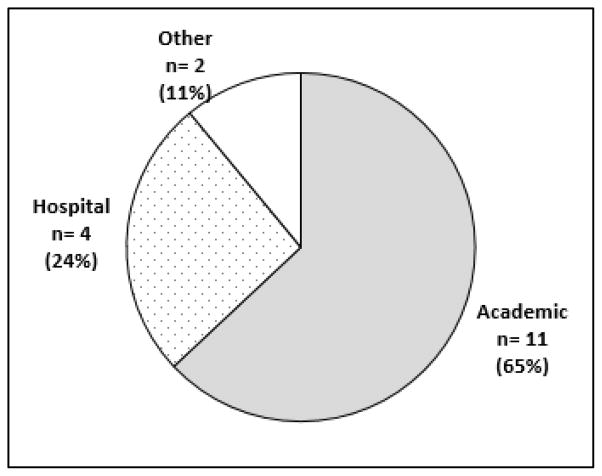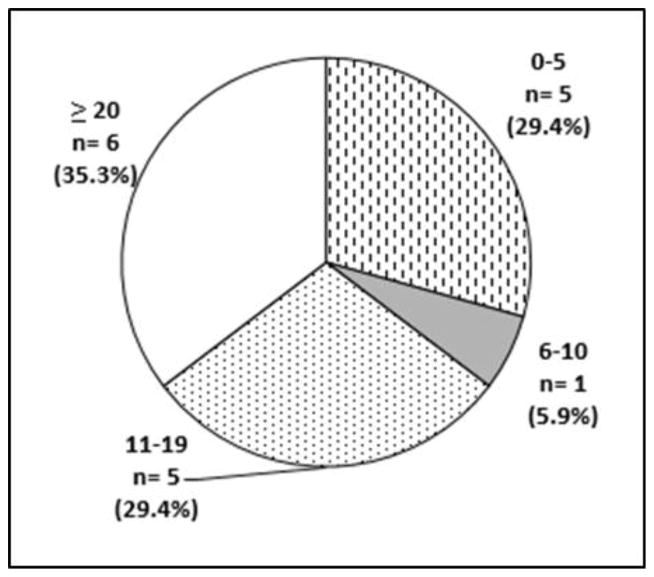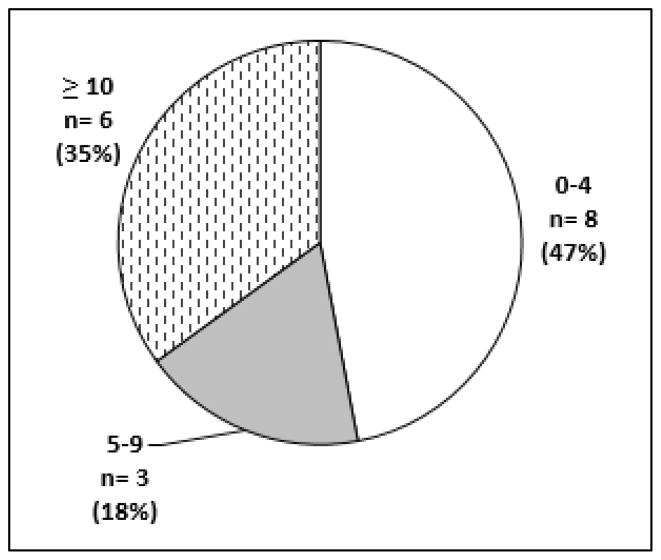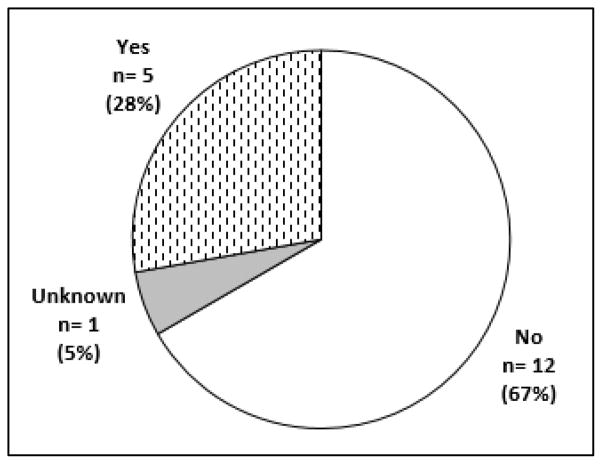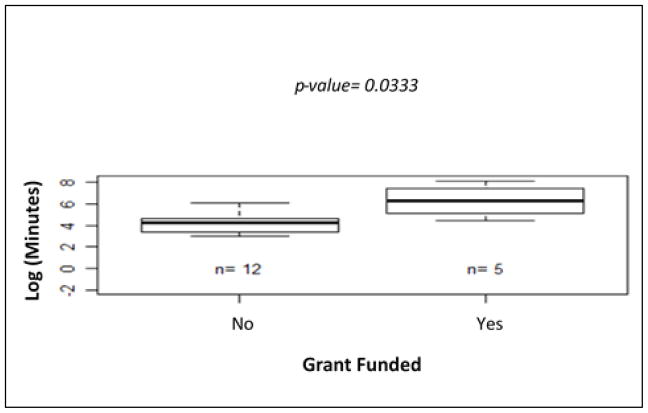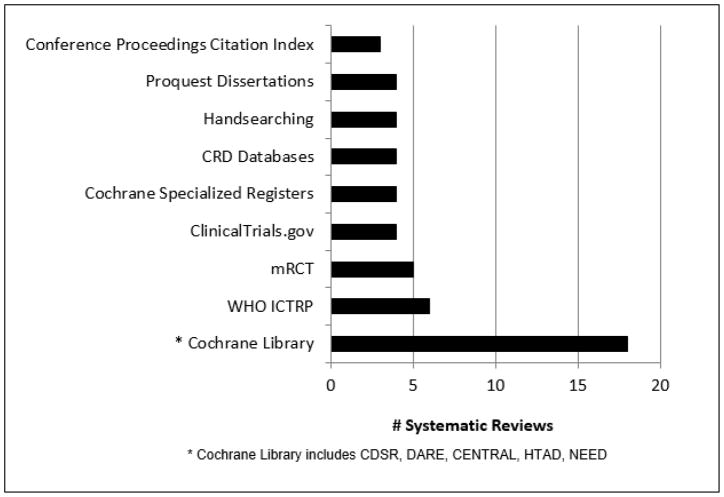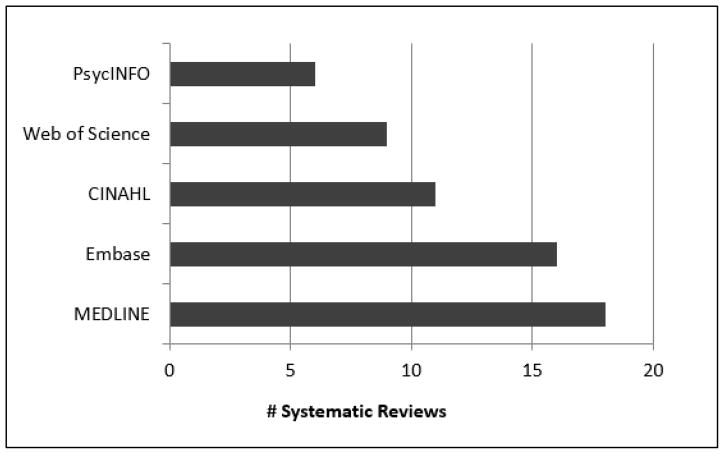Abstract
Objective
To identify estimates of time taken to search grey literature in support of health sciences systematic reviews and to identify searcher or systematic review characteristics that may impact resource selection or time spent searching.
Methods
A survey was electronically distributed to searchers embarking on a new systematic review. Characteristics of the searcher and systematic review were collected along with time spent searching and what resources were searched. Time and resources were tabulated and resources were categorized as grey or non-grey. Data was analyzed using Kruskal-Wallis tests.
Results
Out of 81 original respondents, 21% followed through with completion of the surveys in their entirety. The median time spent searching all resources was 471 minutes, and of those a median of 85 minutes were spent searching grey literature. The median number of resources used in a systematic review search was four and the median number of grey literature sources searched was two. The amount of time spent searching was influenced by whether the systematic review was grant funded. Additionally, the number of resources searched was impacted by institution type and whether systematic review training was received.
Conclusions
This study characterized the amount of time for conducting systematic review searches including searching the grey literature, in addition to the number and types of resources used. This may aid searchers in planning their time, along with providing benchmark information for future studies. This paper contributes by quantifying current grey literature search patterns and associating them with searcher and review characteristics. Further discussion and research into the search approach for grey literature in support of systematic reviews is encouraged.
Introduction
A properly conducted systematic review summarizes the evidence from all relevant studies on a topic concisely and transparently (Cook, Mulrow, & Haynes, 1997). The searches to support these reviews need to be extensive often including extended searches of the grey literature.
Grey literature can be described in a number of ways, but commonly has been defined by the 1997 Luxembourg Convention on Grey Literature definition as literature: “which is produced on all levels of government, academics, business and industry in print and electronic formats, but which is not controlled by commercial publishers” (Farace, 1998, p.iii). In 2004, at the Sixth International Conference on Grey Literature, a postscript was added to further expand on the “commercial publishers” aspects of this definition. In recent years, the definition has stimulated new discussion due to changes in the environment such as the evolving landscape of information dissemination and the introduction of new avenues of scientific communication. According to two-thirds of respondents in the Grey Literature Survey (Boekhorst, Farace, & Frantzen, 2005), “Grey Literature is best described by the type of document it embodies” (p.6). Some examples of grey literature include: reports, conference abstracts, dissertations, and white papers (GreyNet International, 2013).
Systematic review support seems to be of growing interest to health sciences information professionals. A 2013 survey of librarians and directors about emerging roles of biomedical librarians found that support of systematic reviews was one of the top six most common reported new roles (Crum & Cooper, 2013). Furthermore, in a 2013 systematic review of the literature from 1990–2012 on changing roles for health sciences librarians, systematic review librarian was identified as one of the newer roles in the field (Cooper & Crum, 2013).
In recent years, education opportunities relating to systematic review searching have transpired. This is no surprise, given that information professionals planning to get involved in systematic reviews would need to familiarize themselves and learn more about the process and specifically about the search process, as it is distinct from routine literature searches. As an example of these emerging education opportunities, a search of the Medical Library Association’s Educational Clearinghouse (http://cech.mlanet.org/), found eight Continuing Education (CE) courses with the words “systematic review” in the title, and there were at least three CE courses found listed on the Canadian Health Libraries Association website (http://www.chla-absc.ca/node/119). Systematic review as a topic is also emerging in library science curricula as can be found in select content covered in the Certificate of Advanced Study in Health Sciences Librarianship (HealthCAS), Reference Services and Instruction in Healthcare Environments course previously offered through the University of Pittsburgh. The University of Alberta, School of Library Information Studies has a course entitled “Systematic Review Searching”, and the Texas Woman’s University medical library curriculum planned a course for systematic reviews that would be launched in Spring 2014 (C. Perryman, personal communication, July 7, 2013).
In 2011, the Institute of Medicine (IOM) released standards for systematic reviews which indicate that researchers should “take action to address potentially biased reporting of research results” (p.84). To address this bias, Standards 3.2.1 and 3.2.4 call for the inclusion of grey literature searches in all systematic reviews and handsearching of selected journals and conference abstracts (Institute of Medicine [IOM], 2011). These standards may lead to wider acceptance of including grey literature searching in systematic review methodology. As librarians become increasingly integrated into systematic reviews, as called for by the IOM Standard 3.1.1 which specifically states “Work with a librarian or other information specialist trained in performing systematic reviews to plan the search strategy”, they must be prepared to search the grey literature or at least provide guidance on resources and search strategies (IOM, 2011, p.84). Locating grey literature can often be challenging, requiring librarians to utilize a number of databases from various host providers or various websites, some of which they may not be familiar with or aware of. Additionally, searchers may need to spend time learning various search interfaces and the nuances of each resource, such as how to download references or if the search query boxes have term limits (Wright, Cottrell, & Mir, 2014).
Investigation into the grey literature search process for systematic reviews may reveal useful information that can be applied by information specialists planning and preparing for systematic review searches. There is limited information on the time it takes to search grey literature in support of systematic reviews and we are not aware of any studies which relate searcher or systematic review characteristics to either time spent searching the grey literature or which grey literature resources are selected for the search. Therefore, we sought to explore these aspects of the process of grey literature searching in support of systematic reviews.
Literature Review
Acceptance of the inclusion of grey literature in systematic reviews has varied over time. A 2006 survey showed approximately 90% of systematic reviewers and approximately 70% of editors felt grey literature probably or definitely should be eligible for inclusion in systematic reviews, while a prior 1993 survey showed that 78% of meta-analyst and methodologist respondents felt that unpublished material should definitely or probably be included in systematic reviews, and that only 47% of journal editors felt this way (Cook et al., 1993; Tetzlaff, Moher, Pham, & Altman, 2006). The biggest concerns were about the lack of peer review and quality of the studies found in the grey literature. However, other studies detail the benefit of including grey literature in systematic reviews (Crumley, Wiebe, Cramer, Klassen, & Hartling, 2005; Savoie, Helmer, Green, & Kazanjian, 2003). Two Cochrane reviews further support why it is important to search for grey literature. A 2007 Cochrane systematic review on the use of grey literature in meta-analyses of randomized trials found that non-grey literature trials tended to be larger and showed an overall larger treatment effect when compared to grey literature trials (Hopewell, McDonald, Clarke, & Egger, 2007). Another Cochrane systematic review on time to publication for results of clinical trials found that positive result trials tended to be published earlier than negative or null result trials and positive result trials were more likely to be published than negative or null result trials (Hopewell, Clarke, Stewart, & Tierney, 2007). Therefore, when conducting searches for systematic reviews searching for grey literature may be used as a means to minimize the introduction of bias such as publication and time-lag bias.
There is a time cost for including a grey literature search in a review. How much time is difficult to estimate however and, because librarians in an academic or hospital role are often juggling other responsibilities, time management is crucial. There seems to be limited research specifically reporting on the time taken to conduct literature searching for systematic reviews. If time is reported, it is often grouped with other tasks such as article retrieval and screening, or the search time is listed as one number, not denoting the time differences for various resources such as PubMed vs. a grey literature resource such as ClinicalTrials.gov. In an examination of 37 meta-analyses, Allen and Olkin (1999) found that the average systematic review took 1139 hours to complete (with a range of 216 to 2518 hours). Of this time, 588 hours accounted for protocol development, searches, retrieval, abstract management, paper screening, blinding, data extraction and quality scoring and data entry. In a single meta-analysis conducted by Steinberg et al. (1997), a description of the time to complete various systematic review tasks, including screening, extracting data, and writing the manuscript was reported. They estimated the total hours for conducting the review to be 1046 hours (26 weeks) of which 24 hours was used to conduct the literature search. Guise and Viswanathan (2011) estimate that it would take 1–4 weeks to run comparative effectiveness review searches.
Greenhalgh and Peackock (2005) reported the time taken for electronic database searches for their systematic review (including developing the search, refining, and adapting to other databases) as approximately two weeks of a librarian specialist’s time. This article also looked at how productively the time was spent. The two weeks of a librarian’s time “yielded only about a quarter of the sources - an average of one useful paper every 40 minutes of searching” (Greenhalgh & Peacock, 2005, p. 1065). Greenhalgh and Peackock (2005) go into further detail and compares electronic searching with handsearching. A handsearch of 271 journals took approximately a month of time resulting in 24 papers that were included in the final report – “an average of one paper per nine hours of searching” (Greenhalgh & Peacock, 2005, p. 1065).
Using traditional electronic databases to search the literature does not always identify all relevant studies. This can be due to a number of reasons including lack of appropriate indexing terms, lack of indexing all sections of a journal, or research methods not being fully described in the abstract (Hopewell, Clarke, Lefebvre, & Scherer, 2007). Therefore handsearching of journals or conference proceedings would be particularly relevant to include in the systematic review search methodology. The Cochrane Handbook for Systematic Reviews of Interventions defines handsearching as follows: “Handsearching involves a manual page-by-page examination of the entire contents of a journal issue or conference proceedings to identify all eligible reports of trials” (Cochrane Collaboration, 2011, Section 6.2.2.1). Handsearching of conference proceedings could be considered as a type of grey literature searching.
Studies other than Greenhalgh and Peackock have also looked at the time required for handsearching. Additional reported time ranged from 30 minutes per journal issue to 45 minutes - 3 hours per year of a title and this may vary based on subject matter (Adams, Power, Frederick, & Lefebvre, 1994; Armstrong, Jackson, Doyle, Waters, & Howes, 2005; Croft, Vassallo, & Rowe, 1999; Jadad, Carroll, Moore, & McQuay, 1996).
There are a variety of studies that have examined how characteristics such as search experience, relate to search quality, search speed, search effectiveness and the search process (Al-Maskari & Sanderson, 2011; Debowski, 2001; Fenichel, 1981; Hsieh-Yee, 1993; Kuhlthau, 1999). Many of these studies seem to focus on varying experience levels within end-user groups. Though, Tabatabai and Shore (2005) explored how experts (highly experienced librarian professionals), intermediates (final year master of library information studies students) and novices (undergraduate teachers) searched the Web. Significant differences in patterns of search among the different groups were found in cognition, metacognition, and prior knowledge strategies (Tabatabai & Shore, 2005). Previous literature also demonstrates interest in exploring different experience levels in relation to performance of a systematic review. A study (Riaz, Sulayman, Salleh, & Mendes, 2010) reporting on systematic reviewers noted that new systematic reviewers experienced problems with time taken to conduct the review, defining the research question and inclusion/exclusion criteria, and data management that were not faced by experienced systematic reviewers. Given this insight from the literature, it seems useful to consider subject characteristics as variables that may potentially impact outcome searches.
Aims
The purpose of this study was to explore grey literature searching for health sciences systematic reviews. More specifically:
To explore the time taken to conduct grey literature searches for systematic reviews
To explore the resources selected for grey literature searches for systematic reviews
To evaluate whether any relationship exists between searcher and systematic review characteristics and time to search or number of resources selected for grey literature searches in support of systematic reviews
Methods
Study Recruitment
University of Pittsburgh Institutional Review Board (IRB) approval was obtained to conduct the study. Participants were recruited through listservs, social media and email contacts. A total of 19 listservs, including information professional types and those whose subscribers were thought to have an interest in systematic reviews, were used for recruitment. Social media sources included posting on Facebook, posting on popular librarian blogs, and having fellow librarians post tweets. The prerequisite for study enrolment was: the participant must currently be embarking on a literature search to support a systematic review or plan to in the near future. However, searching should not have taken place prior to enrolment. The searcher did not have to be a librarian but had to be the person responsible for building the searches and running them in each database used.
Data Collection
A survey instrument was developed and pilot tested on a small sample which included two systematic review course instructors (a clinician and a biostatistician) and five information specialists. Revisions to the survey forms were made based on feedback. The survey forms were distributed in two parts (see Appendix for surveys). Part one of the survey collected demographic information about the searcher and their systematic review experience and was required to be submitted directly after study enrolment. Part two of the survey was provided to participants after they submitted part one. Return of the part two form was expected upon completion of the systematic review searches. This part of the survey collected information about the systematic review including topic, population, and if the systematic review was grant funded. Participants were also asked to document the name of the resources searched, platform or vendor of the resource, resource URL when applicable, and the time taken to search the resource (electronic database, website searching or handsearching). Reported time was to account for choosing terminology, developing the strategy, refining and running the search.
In order to minimize the potential of bias in the searching, it was not disclosed to subject participants that this was a survey specifically focused on grey literature searching in systematic reviews. Rather, participants were asked to include all resources searched for the systematic review including handsearching. Other means of searching for studies, such as citation tracking (i.e. snowballing) or contacting key authors or experts were not specifically requested in our data collection form.
Email reminders were sent twice to participants who did not submit their completed data forms.
Data Analysis
From the completed surveys, a list of the resources participants used in their systematic review searches was compiled. For some resources various interfaces were used to complete the search i.e. OVID MEDLINE vs. PubMed. In these cases the resources were classified as the same despite the interface used with the exception of Cochrane Library and the Centre for Review and Dissemination (CRD) resources. Some users searched both Cochrane Library and the CRD version of the databases: Database of Abstracts of Reviews of Effects (DARE), NHS Economic Evaluation Database (NHSEED) and Health Technology Assessment (HTA), for the same review. Cochrane Library individual resources were all grouped under “Cochrane Library,” and if a CRD search platform was also used, that resource was categorized separately as “CRD database.”
Once the list of resources was compiled, each resource was labeled as grey literature or non-grey literature. To categorize the resources, the librarian authors used the 1997 Luxembourg definition of grey literature, reviewed the database content, contacted the database content producers as necessary, and used their own expert opinion. Resources that predominately included literature from journals were categorized as non-grey. Resources that included citations mostly from book chapters, theses, reports, conference materials or other type of grey literature were categorized as grey. Because many resources may cover both grey and non-grey literature for these resources, assignment of grey vs. non-grey was based on the authors’ estimation of which type of content was the majority. Handsearching was denoted as a grey literature resource because conference proceedings were primarily handsearched for participant systematic reviews which included handsearching. Once categorization was completed, the number of grey literature vs. non-grey literature resources and the time taken to search each type of resource was tallied.
The six outcomes analyzed were the number of grey, non-grey and total literature resources along with the amount of time searching each of those resources. These outcomes were compared across the searcher and the systematic review characteristics. Continuous variables were compared across groups using a Kruskal-Wallis test instead of a t-test because non-normality in some of the variables violated t-test assumptions. Boxplots comparing the amount of time searching the literature across groups were graphed on the log scale due to a few extremely large values. Kruskal-Wallis tests were performed on the log scales for the amount of time searching the literature across groups to be consistent with the boxplots. Sensitivity analysis without the log transformations yielded similar results.
Results
Out of 81 initial respondents, 17 (21%) completed both parts of the study and were included in the data analysis. Nineteen respondents were excluded because they did not meet the study prerequisites. The remaining respondents withdrew from the study or did not complete both parts of the survey. Of the 17 final participants, 15 reported that their primary professional role was a librarian/information professional.
Searcher Characteristics
Most study participants were from an academic environment (Figure 1). Hospital was reported by 24% and Other, which included one non-government agency and one independent research company, made up 11% (n= 2) of participants’ institution. The participant country representation was mostly comprised of United States (US), Canada, and the United Kingdom (UK) with a few additional countries represented by Other (Figure 2).
Figure 1.
Type of institution where searcher was employed (n= 17).
Figure 2.
Country where searcher was employed (n= 17).
Figures 3 and 4 show that most study participants had greater than 10 years of experience in their profession and at least 5 years of experience in assisting in systematic reviews. The number of systematic review searches that respondents had contributed to ranged from 0 to greater than 50 (Figure 5).
Figure 3.
Searchers’ years of experience in profession (n= 17).
Figure 4.
Searchers’ years of experience contributing to systematic reviews (n= 17).
Figure 5.
Number of systematic reviews searcher has contributed to in the past (n= 17).
Systematic Review Characteristics
Half of the searchers responded that they would be a co-author on the systematic review that they completed the searches for, while the others responded they would not (33%) or were not sure (17%).
With regards to study population, the survey asked about age of the target population. Thirty-nine percent of the systematic reviews focused on adults, 17% pediatric, and 44% focused on both. The breakdown for the methodological focus of the systematic reviews included Therapy (33%), Diagnosis (11%), Prognosis (11%), Other (39%), and Unsure (6%).
An attempt was made to explore whether any relationships existed between systematic review topic and time spent searching and resources used. However, because of the wide range of topics for a small sample size, we were not able to analyze the data in a meaningful way.
Most of the reviews were completed under the guidance of a systematic review producing entity (56%; n= 18). Also the majority of systematic reviews were not grant funded (67%) (Figure 6).
Figure 6.
Grant funded systematic reviews (n= 18).
Time Spent Searching and Number of Resources Searched
Tables 1 and 2 show the time survey participants reported searching resources for their systematic review and the mean number of resources used per systematic review.
Table 1.
Time Spent Searching Resources for Systematic Review Searches
| Time Range (minutes) | Time Mean (minutes) | Time Median (minutes) | Quartiles (Q1,Q3) | |
|---|---|---|---|---|
| Grey Literature Resources | 20–3480 | 395 | 85 | (45,240) |
| All Resources | 96–6780 | 1457 | 471 | (255,2104) |
Table 2.
Number of Resources Utilized for Systematic Review Searches
| Resources Range (number) | Resources Mean (number) | Resources Median (number) | Quartiles (Q1,Q3) | |
|---|---|---|---|---|
| Total Resources Searched | 3–27 | 9 | 8 | (5,10) |
| Grey Literature Resources Searched | 1–14 | 4 | 2 | (1.25,5.5) |
| Non-Grey Literature Resources Searched | 2–13 | 5 | 4 | (3,5.75) |
Using the Kruskal-Wallis test we examined whether the time spent searching resources for a systematic review or the number of resources used for a systematic review search varied by the characteristics of a systematic review (grant funded, under guidance of a systematic review producing entity, etc.) or of an individual searcher (institution, country, systematic review training, etc.).
Figures 7–10 use boxplots to visualize the statistically significant (p ≤ 0.05) findings. In the boxplots the thick dark horizontal line represents the median value. The bottom and top of the box are the first (Q1) and third (Q3) quartiles where 25% of the data is below Q1 and 75% is below Q3. The “whiskers” extending from the boxes show the spread of the data with outliners represented as dots (as in Figures 9 and 10).
Figure 7.
Time spent searching grey literature for a systematic review (n= 17).
Figure 10.
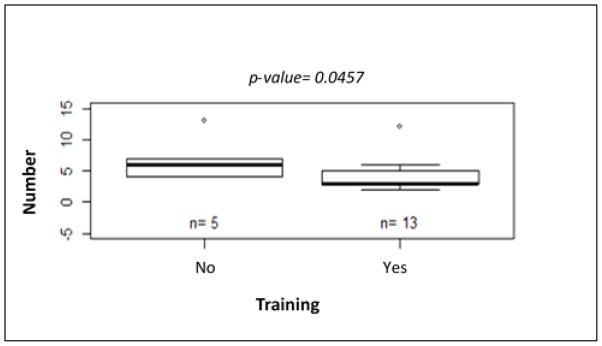
Number of non-grey literature resources used for a systematic review (n= 18).
Figure 9.
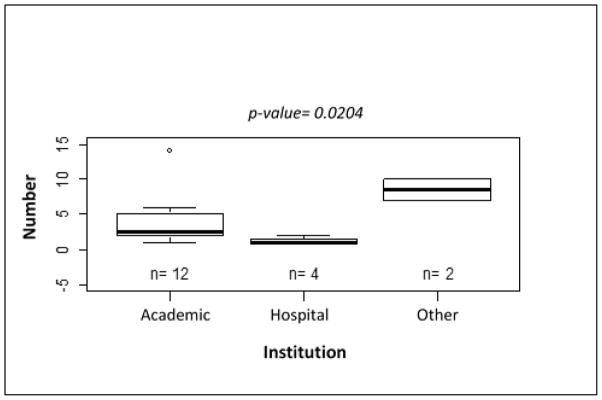
Number of grey literature resources used for a systematic review (n= 18).
The time spent searching can be obtained by exponentiating the log (minutes) in Figures 7 and 8. Specifically, whether or not the systematic review was grant funded was associated with the amount of time spent searching for both grey literature (median [Q1, Q3] for grant funded: 544.5 [211.4, 1339.4] minutes and not grant funded: 66.7 [36.6, 109.9] minutes, p=0.03) and non-grey literature (median [Q1, Q3] for grant funded: 1480.3 [365.0, 3294.5] minutes and not grant funded: 270.4 [164.0, 492.7] minutes, p=0.05) (Figures 7 and 8). The number of resources searched for the systematic reviews varied by the searchers’ institution (median [Q1–Q3] for academic: 2.5 [2.0, 4.5]; hospital: 1.0 [1.0, 1.3]; and Other: 8.5 [7.8, 9.3], p=0.02) and whether the searcher received systematic review training (median [Q1–Q3] for trained: 3.0 [3.0, 5.0]; and untrained: 6.0 [4.0, 7.0], p=0.045) (Figures 9 and 10).
Figure 8.
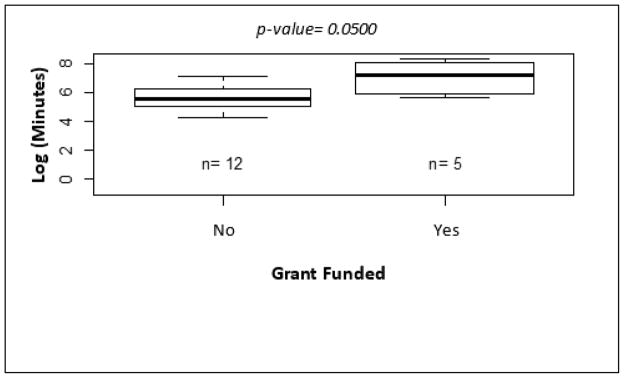
Time spent searching non-grey literature for a systematic review (n=17).
Resources Searched
Figures 11 and 12 show the most common grey and non-grey literature resources reported as being used by the 17 study participants.
Figure 11.
Top grey literature resources searched for a systematic review (n= 18).
Figure 12.
Top non-grey literature resources searched for a systematic review (n= 18).
Discussion
The results of this study found that the average total time spent searching electronic databases and handsearching the literature for a systematic review was 24 hours with a range of 2 to 113 hours with 50% of the participants reporting spending less than 8 hours. Our study also more specifically identified time taken to search the grey literature for a systematic review. All systematic reviews reported (n= 18) included some form of grey literature searching. The average time taken to conduct the grey literature search was approximately 7 hours, with range of 20 minutes to 58 hours, with 50% of the participants reporting spending less than 1.5 hours. The grey literature search represents 27% of the total time of the literature search on average, with 50% of the participants spending 20% or less of their time searching grey literature.
When reporting time spent searching, survey respondents were asked to account for choosing terminology, developing the strategy, refining, and running the search. Depending on how the instruction “running the search” was interpreted response times could be skewed low. Although not specifically stated, we aimed to have the time requested on the survey to capture the time required for searchers to navigate and learn the nuances of the databases used for grey literature searching as they prepare the search approach. Grey literature electronic resources are often limited and crude in search capability. Truncation of terms may not be possible, search boxes may be limited in the number of characters they accept, little or no search help documentation may be provided and no export feature may be available. Because of these limitations the searcher may spend more time searching the database than anticipated. Grey literature resources are also not routinely searched by the average health sciences librarian for everyday work. Because of this, database unfamiliarity may also require searchers to spend more time searching the grey literature.
As previously mentioned, all reviews reported included some form of grey literature searching. An average of four grey literature resources were searched per review, with a range of one to 14 resources and with 50% of the participants reporting using one or two grey literature resources. The number of resources selected for the grey literature search may be restricted due to time constraints if there is pressure to complete the systematic review within a short time period. Also resource selection may be impacted by resource access which may be limited depending on institutional subscriptions. We did not ask searchers what, if anything, impacted or limited the number of resources selected, especially for grey literature. We did ask if a resource was purchased as a one-time paid subscription for purposes of a search for the systematic review, however no respondents reported this to be the case. Locating resources to search for grey literature is important and worth noting as one of the challenges with searching the grey literature. It is possible that problems locating grey literature resources impacted the number of resources used by participants in the study.
As shown in Figures 11 and 12, MEDLINE and Cochrane Library were used in all the reviews reported in this study. Following the Cochrane Library, the next most commonly used grey literature resources were the World Health Organization International Clinical Trials Registry Platform (WHO ICTRP) (n= 6) and the metaRegister of Controlled Trials (mRCT) (n= 5).
It is not surprising that the Cochrane Library, produced by the Cochrane Collaboration, led the ranking of the grey literature resource searched. The Cochrane Collaboration, which recently celebrated their 20th anniversary is widely known for generating systematic reviews and is respected by both researchers and librarians alike (Friedrich, 2013). The Cochrane Library provides access to the CENTRAL database, which includes randomized and controlled clinical trials obtained not only from electronic database searches but also from the journal and conference proceeding handsearching efforts of the Cochrane Collaboration. Furthermore, the Cochrane Library includes access to the HTA database and the NHSEED which contain indexed reports.. For this reason, the Cochrane Library was classified as a source of grey literature for the purpose of this study. It should be noted that 56% of the systematic reviews reported in this survey were conducted under the guidance of a systematic review entity. This may include the Cochrane Collaboration, for which documentation in the editorial policies requires the search of CENTRAL for all Cochrane Systematic Reviews (Chandler, Churchill, Higgins, Lasserson, & Tovey, 2013). It is possible that this could have influenced why the Cochrane Library was found to be the top grey literature resource used. The two grey literature resources that were the next most commonly used were the WHO ICTRP and mRCT. Both of these resources allow federated searching across multiple trial registries including ClinicalTrials.gov. Searching such resources would ideally reduce the need to search several trial registries, a possible explanation for their appearance in our top grey literature resources searched list and perhaps why they may have appeared higher on the list compared to ClinicalTrials.gov.
Also evaluated was whether time spent searching or the number of resources selected varied by searcher or review characteristics. As shown in Figures 7 and 8 the amount of time spent searching for both grey and non-grey literature was impacted by whether or not the systematic review was grant funded. More time was spent searching both types of resources if the systematic review was grant funded. The explanation for this finding is unclear. It may be that there are differences as to how funded systematic reviews are conducted compared to non-funded systematic reviews. A 2007 study (Reed et al., 2007) on the association of funding and quality of published medical education research found differences in the quality of funded studies. Perhaps a funded systematic review has more resources available in terms of manpower and technology because of funding.
Another finding was that the number of resources searched was impacted by the searcher characteristics. The number of literature resources varied by institution (academic, hospital or other). When performing all two-way comparisons, we found that those who work in academic settings used fewer grey literature resources than those who work in other settings (p = 0.03) and that those who work in hospitals use fewer numbers of grey literature resources than those who work in other settings (p = 0.049). Academic- and hospital-affiliated information professionals are often juggling a multitude of responsibilities and therefore may not have as much time to devote to each systematic review search and therefore it is possible that this leads to fewer grey literature resources being used in the search. The number of non-grey literature resources searched also varied by whether the individual received systematic review training. If systematic review training was received, the number of non-grey literature resources was decreased. It is unclear why such a relationship is evident. Perhaps those with training can more readily select the pertinent databases for the systematic review topic or feel more confident with being selective. Our survey cannot conclude this however. Searchers with less training may take precaution and therefore select a large number of resources to search and spend a long time searching. Again, there is no certain explanation for our results. Many variables may contribute, including whether there is a fair amount of time allotted to locating studies.
Limitations
There are several limitations in this study that are worth noting. We utilized convenience sampling, recruiting mainly through known listservs. Of the respondents who started the survey, only 21% completed the survey. The reasons for this non-completion are not known, although it is possible that the second part of the survey was viewed as too onerous or that the planned systematic review never progressed to the searching phase. There was limited power in the analysis due to the small sample size, so results should be viewed as suggestive rather than predictive. Also, because the small sample size consisted of mainly library professionals, results may not be generalizable to all those undertaking a systematic review search. Part two of this survey study utilized prospective methodology, asking participants to record information about their systematic review searching as they worked. Perhaps if a retrospective methodology was used more potential participants would have met our inclusion criteria, resulting in a larger sample size. However, it was the feeling of the authors that a prospective survey would allow the least biased capture of time spent searching. A further limitation regarding methodology of the study was the subjective categorization of resources into grey literature or non-grey literature by the authors.
The time for searching that we obtained through this study may be underreported due to the following: five survey participants reported that a portion of the searching was completed by another individual but only reported the name of the resource, not time spent searching. Two survey participants did not report the time spent searching each resource individually; they only reported the total time as whole which was spent searching all resources for the review.
Future Directions
This study draws attention to the need for further research on search methodology in systematic reviews and grey literature. Furthermore, there is a need for guidelines on conducting systematic review searches including grey literature searching. Some earlier literature demonstrates searchers’ recognition of issues with searching grey literature, and with the approach to searching for comprehensive literature reviews. In a Canadian report (Dobbins, Robeson, Jentha & DesMeules, 2008), a methodology for the grey literature search to support evidence syntheses in public health was explored. Tyndall (2008) opens up discussion of the grey literature search process by suggesting a hierarchy for acceptable grey literature. Bidwell’s COSI model (Bidwell & Jensen, 2003), a model proposed for searches to support technology assessment reports is an example of an approach that can be revisited to address this matter. The COSI model relates to the whole search process and uses a framework or protocol to categorize resources into three levels of priority based on expectation of yield. The acronym COSI, and levels of priority, include CO for core search, S for standard search, and I for ideal search (Bidwell & Jensen, 2003). If there is sufficient time to undertake the search, the Ideal search of resources is proposed. Information professionals conducting searches for systematic reviews have little guidance to assist them with the approach and how to conduct the searches. For information specialists embarking on systematic review searches, questions may arise as to which resources to search, how many, how far to go in breadth of resources. Perhaps, a similar concept to the COSI model can be used to develop a framework for guidance in grey literature searching in support of systematic reviews.
Hopewell, McDonald, et al. (2007) found that studies included in systematic reviews, located through grey literature searching, were more commonly conference abstracts or unpublished data (trial registers, file drawer data, data from individual trialists). Additional types of grey literature identified in the review include: book chapters, unpublished reports, pharmaceutical company data, in press publications, and letters and theses (Hopewell, McDonald, et al., 2007). The study findings could potentially be used to support development of a framework that would prioritize resources by the document types that they include, with the thought that certain types of documents are more often found useful for inclusion into systematic reviews. The aforementioned are just several examples for illustration purposes. A more national/international collaborative effort by an authoritative body would be best to propose systematically developed guidance.
It should be noted that a number of guides exist which list grey literature resources to search and explain the importance of searching grey literature (Canadian Agency for Drugs and Technologies in Health, 2013; Centre for Reviews and Dissemination, 2009; Cochrane Collaboration, 2011). Many of these guides can be helpful to identify possible resources but some are merely lists, and while some explain the importance of select types of items they do not highlight an approach or framework for following through with the entire grey literature search process. Furthermore, only a select few are designed specifically for information professionals.
Exploration of the systematic review search process regarding grey literature including time taken to search, resources used, and investigation of any relating characteristics which may impact these factors is one step forward toward engaging the health sciences library community in further discussion about grey literature. Many information professionals are multi-tasking, such as is the case with academic health science librarians and hospital librarians, and therefore time management is of great interest in order to efficiently integrate systematic review searching into one’s routine responsibility.
Conclusion
We sought to prospectively explore the time taken to conduct grey literature searches, via electronic database searching and handsearching, for systematic reviews and to evaluate whether any relationship exists between searcher and systematic review characteristics. The mean time taken to conduct grey literature searches was approximately 7 hours, with 50% of the searchers reporting less than 1.5 hours spent. This mean time represents 27% of the total time taken to complete the systematic review literature search. Time spent searching both the grey and non-grey literature was influenced by whether or not the systematic review was grant funded. The time estimates given in this study are for searching-related activities only and do not include other potential librarian efforts involved in participating in the synthesis of a review such as meetings with the review requestor and the systematic review team and managing citations. However, the time estimate provided for searching both the grey literature and non-grey literature resources can provide direction for librarians when meeting with researchers, writing a grant for a completing a systematic review, or simply managing their own time. The top resources used by the participants in this study might provide a reference point for librarians working on a systematic review.
In light of recently established systematic review standards, we expect some changes in the landscape of systematic review searching. Additionally, we hope that in the near future grey literature searching standards for systematic reviews are developed by the librarian community for information professionals.
Acknowledgments
This project is supported in part by the National Institutes of Health through Grant Numbers UL1 RR024153 and UL1TR000005.
We would like to thank Dave Piper for review of the manuscript.
Appendix
Survey -Part One
CONTACT INFORMATION - solely used for communication with you regarding the study
First Name
Last Name
Institution/Organization
E-mail
Phone
INFORMATION ABOUT THE SEARCHER
Country of Employment
List Academic Credentials (e.g., PhD, MLIS, MPH)
-
Type of Institution
Academic
Hospital
Industry/Corporation
Government Agency
Organization/Agency (non-Government)
Other (If Other, specify)
Position Title
-
Select an option which represents your primary professional role
Librarian/Information Professional
Researcher
Healthcare Professional
Statistician
Student
Other (If Other, specify)
Years of experience in your profession (that you selected in Question 5)?
Have you had any formal training on how to conduct literature searching for Systematic Reviews? YES/NO
Approximately how many years of experience do you have contributing to Systematic Reviews?
Approximately how many Systematic Reviews have you contributed to in the past?
Survey -Part Two
INFORMATION ABOUT THE SYSTEMATIC REVIEW (SR)
-
1
Please list the title or the topic of the SR.
Note- This information will only be used to classify the SRs into subject categories.
-
2
Please select the population age group included in the SR.
Adults
Pediatrics
Both
-
3
Which category best describes the type of Systematic Review?
Therapy
Diagnosis
Prognosis
Etiology
Adverse Effects
Methodology
Other
Not Sure
-
4
Is this SR grant funded? YES/NO
-
5
Is this SR being produced under the guidance of a systematic review funding or producing agency/organization? YES/NO/NOT SURE
-
6
Should the SR be published, are there plans for you to be a coauthor? YES/NO/NOT SURE
-
7
If you are NOT a librarian/information professional, is there one involved in the SR?
If you are a librarian/information professional select N/A
YES/NO/N/A
If YES, in what primary role?
Manage project
Overall search responsibility
Assist with search strategy design
Suggest resources
Provide general guidance
Assist with full text acquisition
Other
INFORMATION ABOUT SEARCHING FOR THE SYSTEMATIC REVIEW (SR)
-
8
Is cited reference searching (checking who cited a paper) or checking the reference lists of papers of interest, planned as part of the search effort for this SR?
Cited reference searching
Checking reference lists
Both
None
-
9
Will a methodology filter be used in the SR search? (A methodology filter is a pre-designed search strategy with terms related to research methodology. Examples include the Cochrane Highly Sensitive Search Strategy and Clinical Queries.) YES/NO
If YES, for which resources?
-
10
Were any resources purchased as a one-time paid subscription for purposes of a search for the SR? YES/NO
-
11
May we contact you to ask for the final number of studies included and where the citations were originally found? YES/NO
-
12
Use the following table to document all resources searched for the SR.
If any journals or conference proceedings were handsearched, label with Handsearch followed by a dash and the Title of the Resource in the RESOURCE NAME column. Indicate in RESOURCE Platform column whether the print or electronic version was handsearched
If a resource was purchased as a one-time paid subscription for purposes of a search for this SR, please mark with an asterisk (*) preceding the resource name in the RESOURCE NAME column.
Use n/a if an item does not apply, to indicate that you are unable to identify the information, or if the information is not available
Three examples are provided, although the time is not documented
| ANOTHER1 | DATE SEARCHED |
RESOURCE NAME |
RESOURCE Platform/ Interface/ Vendor |
RESOURCE URL |
TIME in minutes2 |
|---|---|---|---|---|---|
| 1/22/2010 | * BIOSIS Previews | Dialog | n/a | Insert Time Here | |
| 2/10/2010 | clinicaltrials.gov | n/a | clinicaltrials.gov | Insert Time Here | |
| x | 1/4/2010-3/1/2010 | Handsearch-Proceedings of the Nutritional Society (2007–2009) | n/a | Insert Time Here | |
Mark with an X resources you did not search yourself but that were searched for the SR
Time should account for choosing terminology, developing the strategy, and running the search
Contributor Information
Ahlam A. Saleh, Email: asaleh@ahsl.arizona.edu, Assistant Librarian Arizona Health Sciences Library, University of Arizona, Tucson, Arizona, United States of America
Melissa A. Ratajeski, Email: mar@pitt.edu, Reference Librarian, Health Sciences Library System, University of Pittsburgh, Pittsburgh, Pennsylvania, United States of America
Marnie Bertolet, Email: mhb12@pitt.edu, Assistant Professor, Graduate School of Public Health, University of Pittsburgh Pittsburgh, Pennsylvania, United States of America.
References
- Adams CE, Power A, Frederick K, Lefebvre C. An investigation of the adequacy of MEDLINE searches for randomized controlled trials (RCTs) of the effects of mental health care. Psychological Medicine. 1994;24(3):741–748. doi: 10.1017/s0033291700027896. doi: http://dx.doi.org/10.1017/S0033291700027896. [DOI] [PubMed] [Google Scholar]
- Al-Maskari A, Sanderson M. The effect of user characteristics on search effectiveness in information retrieval. Information Processing & Management. 2011;47(5):719–729. doi: http://dx.doi.org/10.1016/j.ipm.2011.03.002. [Google Scholar]
- Allen IE, Olkin I. Estimating time to conduct a meta-analysis from number of citations retrieved. Journal of the American Medical Association. 1999;282(7):634–635. doi: 10.1001/jama.282.7.634. [DOI] [PubMed] [Google Scholar]
- Armstrong R, Jackson N, Doyle J, Waters E, Howes F. It’s in your hands: the value of handsearching in conducting systematic reviews of public health interventions. Journal of Public Health. 2005;27(4):388–391. doi: 10.1093/pubmed/fdi056. doi: http://dx.doi.org/10.1093/pubmed/fdi056. [DOI] [PubMed] [Google Scholar]
- Bidwell S, Jensen MF. Using a search protocol to identify sources of information: the COSI model. Etext on Health Technology Assessment (HTA) Information Resources. National Information Center on Health Services Research and Health Care Technology (NICHSR) 2003 Retrieved from http://www.nlm.nih.gov/archive/20060905/nichsr/ehta/chapter3.html.
- Boekhorst AK, Farace DJ, Frantzen J. In: Farace DJ, Frantzen J, editors. Grey literature survey 2004: A research project tracking developments in the field of grey literature; Proceedings from Sixth International Conference on Grey Literature: Work on Grey in Progress; 6–7 December 2004; Amsterdam: TextRelease; 2005. pp. 1–9. [Google Scholar]
- Canadian Agency for Drugs and Technologies in Health. Grey matters: a practical deep-web search tool for evidence-based medicine. 2013 Retrieved from http://www.cadth.ca/media/pdf/Grey-Matters_A-Practical-Search-Tool-for-Evidence-Based-Medicine.doc.
- Centre for Reviews and Dissemination. Systematic reviews: CRD’s guidance for undertaking reviews in healthcare. 2009 Retrieved from http://www.york.ac.uk/inst/crd/pdf/Systematic_Reviews.pdf.
- Chandler J, Churchill R, Higgins J, Lasserson T, Tovey D. Methodological standards for the conduct of new Cochrane Intervention Reviews. Cochrane Editorial Unit, editor. Methodological Expectations of Cochrane Intervention Reviews (MECIR) 2013 Retrieved from http://www.editorial-unit.cochrane.org/sites/editorial-unit.cochrane.org/files/uploads/MECIR_conduct_standards%202.3%2002122013.pdf.
- Cochrane Collaboration. Higgins JPT, Green S, editors. Cochrane Handbook for Systematic Reviews of Interventions. 2011 Retrieved from http://www.cochrane-handbook.org.
- Cook DJ, Guyatt GH, Ryan G, Clifton J, Buckingham L, Willan A, McIlroy W, Oxman AD. Should unpublished data be included in meta-analyses? Current convictions and controversies. Journal of the American Medical Association. 1993;269(21):2749–2753. doi: http://dx.doi.org/10.1001/jama.1993.03500210049030. [PubMed] [Google Scholar]
- Cook DJ, Mulrow CD, Haynes RB. Systematic reviews: synthesis of best evidence for clinical decisions. Annals of Internal Medicine. 1997;126(5):376–380. doi: 10.7326/0003-4819-126-5-199703010-00006. doi: http://dx.doi.org/10.7326/0003-4819-126-5-199703010-00006. [DOI] [PubMed] [Google Scholar]
- Cooper ID, Crum JA. New activities and changing roles of health sciences librarians: a systematic review, 1990–2012. Journal of the Medical Library Association. 2013;101(4):268–277. doi: 10.3163/1536-5050.101.4.008. doi: http://dx.doi.org/10.3163/1536-5050.101.4.008. [DOI] [PMC free article] [PubMed] [Google Scholar]
- Croft AM, Vassallo DJ, Rowe M. Handsearching the Journal of the Royal Army Medical Corps for trials. Journal of the Royal Army Medical Corps. 1999;145(2):86–88. doi: 10.1136/jramc-145-02-09. doi: dx.doi.org/10.1136/jramc-145-02-09. [DOI] [PubMed] [Google Scholar]
- Crum JA, Cooper ID. Emerging roles for biomedical librarians: a survey of current practice, challenges, and changes. Journal of the Medical Library Association. 2013;101(4):278–286. doi: 10.3163/1536-5050.101.4.009. doi: http://dx.doi.org/10.3163/1536-5050.101.4.009. [DOI] [PMC free article] [PubMed] [Google Scholar]
- Crumley ET, Wiebe N, Cramer K, Klassen TP, Hartling L. Which resources should be used to identify RCT/CCTs for systematic reviews: a systematic review. BMC Medical Research Methodology. 2005;5:24. doi: 10.1186/1471-2288-5-24. doi: http://dx.doi.org/10.1186/1471-2288-5-24. [DOI] [PMC free article] [PubMed] [Google Scholar]
- Debowski S. Wrong way: go back! An exploration of novice search behaviours while conducting an information search. The Electronic Library. 2001;19(6):371–382. [Google Scholar]
- Dobbins M, Robeson P, Jentha N, DesMeules M. Grey Literature: A methodology for searching the grey literature for effectiveness evidence syntheses related to public health: A report from Canada. Health Inform. 2008;17(1):9–12. [Google Scholar]
- Farace DJ. Forward. In: Farace DJ, editor. GL’97 Conference Proceedings: Perspectives on the Design and Transfer of Scientific and Technical Information. Amsterdam: TransAtlantic; 1998. [Google Scholar]
- Fenichel CH. Online searching: Measures that discriminate among users with different types of experiences. Journal of the American Society for Information Science. 1981;32(1):23–32. doi: http://dx.doi.org/10.1002/asi.4630320104. [Google Scholar]
- Friedrich MJ. The Cochrane Collaboration turns 20: Assessing the evidence to inform clinical care. Journal of the American Medical Association. 2013;309(18):1881–1882. doi: 10.1001/jama.2013.1827. doi: http://dx.doi.org/10.1001/jama.2013.1827. [DOI] [PubMed] [Google Scholar]
- Greenhalgh T, Peacock R. Effectiveness and efficiency of search methods in systematic reviews of complex evidence: audit of primary sources. British Medical Journal. 2005;331(7524):1064–1065. doi: 10.1136/bmj.38636.593461.68. doi: http://dx.doi.org/10.1136/bmj.38636.593461.68. [DOI] [PMC free article] [PubMed] [Google Scholar]
- GreyNet International. Document types in grey literature. 2013 Retrieved 07/09/2013, from http://www.greynet.org/greysourceindex/documenttypes.html.
- Guise JM, Viswanathan M. Overview of best practices in conducting comparative-effectiveness reviews. Clinical Pharmacology & Therapeutics. 2011;90(6):876–882. doi: 10.1038/clpt.2011.239. doi: http://dx.doi.org/10.1038/clpt.2011.239. [DOI] [PubMed] [Google Scholar]
- Hopewell S, Clarke MJ, Lefebvre C, Scherer RW. Handsearching versus electronic searching to identify reports of randomized trials. Cochrane Database of Systematic Reviews. 2007:MR000001. doi: 10.1002/14651858.MR000001.pub2. doi: http://dx.doi.org/10.1002/14651858.MR000001.pub2. [DOI] [PMC free article] [PubMed]
- Hopewell S, Clarke MJ, Stewart L, Tierney J. Time to publication for results of clinical trials. Cochrane Database of Systematic Reviews. 2007:MR000011. doi: 10.1002/14651858.MR000011.pub2. doi: http://dx.doi.org/10.1002/14651858.MR000011.pub2. [DOI] [PMC free article] [PubMed]
- Hopewell S, McDonald S, Clarke MJ, Egger M. Grey literature in meta-analyses of randomized trials of health care interventions. Cochrane Database of Systematic Reviews. 2007:MR000010. doi: 10.1002/14651858.MR000010.pub3. doi: http://dx.doi.org/10.1002/14651858.MR000010.pub3. [DOI] [PMC free article] [PubMed]
- Hsieh-Yee I. Effects of search experience and subject knowledge on the search tactics of novice and experienced searchers. Journal of the American Society for Information Science. 1993;44(3):161–174. doi: http://dx.doi.org/10.1002/(SICI)1097-4571(199304)44:3<161::AID-ASI5>3.0.CO;2-8. [Google Scholar]
- Institute of Medicine. Finding what works in health care: Standards for systematic reviews. Washington DC: National Academies Press; 2011. Retrieved from www.nap.edu/openbook.php?record_id=13059. [PubMed] [Google Scholar]
- Jadad AR, Carroll D, Moore A, McQuay H. Developing a database of published reports of randomised clinical trials in pain research. Pain. 1996;66(2–3):239–246. doi: 10.1016/0304-3959(96)03033-3. [DOI] [PubMed] [Google Scholar]
- Kuhlthau CC. The role of experience in the information search process of an early career information worker: Perceptions of uncertainty, complexity, construction, and sources. Journal of the American Society for Information Science. 1999;50(5):399–412. doi: http://dx.doi.org/10.1002/(Sici)1097-4571(1999)50:5<399::Aid-Asi3>3.0.Co;2-L. [Google Scholar]
- Reed DA, Cook DA, Beckman TJ, Levine RB, Kern DE, Wright SM. Association between funding and quality of published medical education research. Journal of the American Medical Association. 2007;298(9):1002–1009. doi: 10.1001/jama.298.9.1002. doi: http://dx.doi.org/10.1001/jama.298.9.1002. [DOI] [PubMed] [Google Scholar]
- Riaz M, Sulayman M, Salleh N, Mendes E. Experiences conducting systematic reviews from novices’ perspective. In: Turner M, Niazi M, editors. Proceedings of the 14th international conference on Evaluation and Assessment in Software Engineering. Swinton: British Computer Society; 2010. pp. 44–53. [Google Scholar]
- Savoie I, Helmer D, Green CJ, Kazanjian A. Beyond Medline: Reducing bias through extended systematic review search. International Journal of Technology Assessment in Health Care. 2003;19(1):168–178. doi: 10.1017/s0266462303000163. doi: http://dx.doi.org/10.1017/S0266462303000163. [DOI] [PubMed] [Google Scholar]
- Steinberg KK, Smith SJ, Stroup DF, Olkin I, Lee NC, Williamson GD, Thacker SB. Comparison of effect estimates from a meta-analysis of summary data from published studies and from a meta-analysis using individual patient data for ovarian cancer studies. American Journal of Epidemiology. 1997;145(10):917–925. doi: 10.1093/oxfordjournals.aje.a009051. [DOI] [PubMed] [Google Scholar]
- Tabatabai D, Shore BM. How experts and novices search the Web. Library & Information Science Research. 2005;27(2):222–248. doi: http://dx.doi.org/10.1016/j.lisr.2005.01.005. [Google Scholar]
- Tetzlaff J, Moher D, Pham B, Altman D. Survey of views on including grey literature in systematic reviews. XIV Cochrane Colloquium; Dublin, Ireland. 2006. Oct, [Google Scholar]
- Tyndall J. How low can you go? Toward a hierarchy of grey literature. Dreaming08: Australian Library and Information Association Biennial Conference; Alice Springs, Australia. 2008. Sep, [Google Scholar]
- Wright JM, Cottrell DJ, Mir G. Searching for religion and mental health studies required health, social science, and grey literature databases. Journal of Clinical Epidemiology. 2014;67(7):800–810. doi: 10.1016/j.jclinepi.2014.02.017. doi: http://dx.doi.org/10.1016/j.jclinepi.2014.02.017. [DOI] [PubMed] [Google Scholar]



